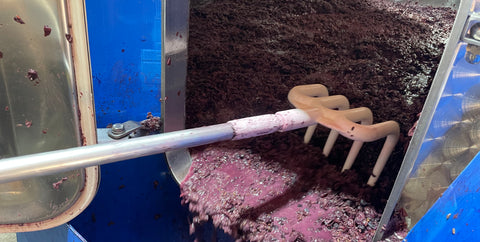The gentle act of separating the juice from the skins and seeds.
There are many different kinds of presses for wine. From the most traditional basket presses to the modern and highly sophisticated pneumatic press like ours. It presses by inflating a big ballon inside the press chamber squeezing the grapes against the out walls of the press.

Same for all presses is that they work to press the grape must from the solid matters. For the whites and rosés this is done after de-stemming and crushing in the early stages of winemaking. For the reds this is done after fermentation when the wine has macerated long enough on the skins to have extracted the colour, aroma and tannins we want from the skins.
Our press is highly sophisticated and allows us to press gently and slowly and create even very small batches of grapes individually. This is key for us with so many different grape varieties and many different plots, unique fermentations and wines.
In general we press at very low pressure. The harder you press the more astringent tannins you press out of the skins and pips of the grapes.
Our press has an integrated computer and we use different pressing programs for our whites, rosé and reds, respectively.

For our whites we use a 10 step sequential program that runs over just about 2 hours and presses a bit harder on each sequence ending at 1,6 bar on the last step/“inflation” of the ballon. During the pressing we also rotate the press to further even the pressing. The first 5 sequences we rotate 1 time per sequence and the last 5 we rotate twice on each sequence.


For the rosé we run a 8 sequence program, but with a MUCH softer press as we only want a bit of the color from the skins in the wine. It also runs shorter than the for the white wines at a total of 1 1/2 hour. We start at 0 bar, increasing gradually up to 1,2 bar on sequence 8. Here we rotate once on the first 5 sequences and twice on the last 3.
When we press our reds they have been fermenting on the skins already for around 2 weeks with several daily punch-downs and pump-overs. This means that the skins are already broken substantially down and thus require less pressing. Also, we have already extracted almost all the color and tannin from the skins that we need which also means a softer pressing.
First we pump the wine over into an empty vat until only the “hat” of wine mixed with grapeskins is left. This we then pump into the press. Here we usually first let the wine run free out of the press for about 15-30min, then start increasing the pressure for another 15 min, but only use the wine till we reach a max of 0,2 bar. This happens over the first 1-2 sequences of a total of 8.


After that we keep pressing for around 30 min to a max of 1,2 bar but pump that last part of the press into a separate vat which we call our “press wine”. This wine is super tannic and astringent, but we can sometimes use it in blends to adjust structure. This gives a total pressing time of 11/2 hours.

For the reds we also run rotations. 4 in the first sequence during the free flowing without any pressure. Then 1 during the second sequence at 0,1bar and 3 during the 3rd sequence that takes the pressure up to 0,2 bar. The last sequence for the “real wine” where we take the pressure up to 0,4 we do not do any rotations.

